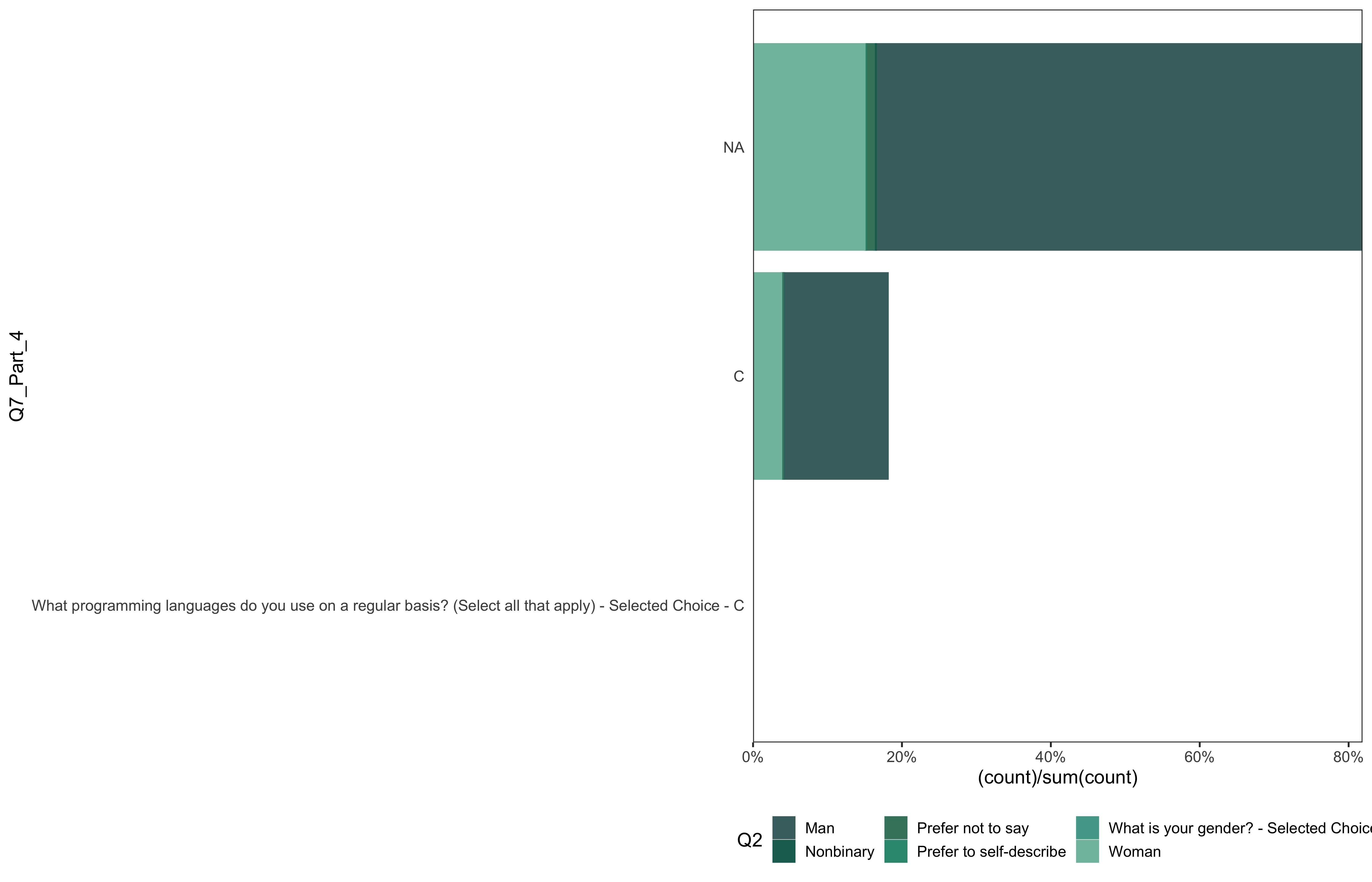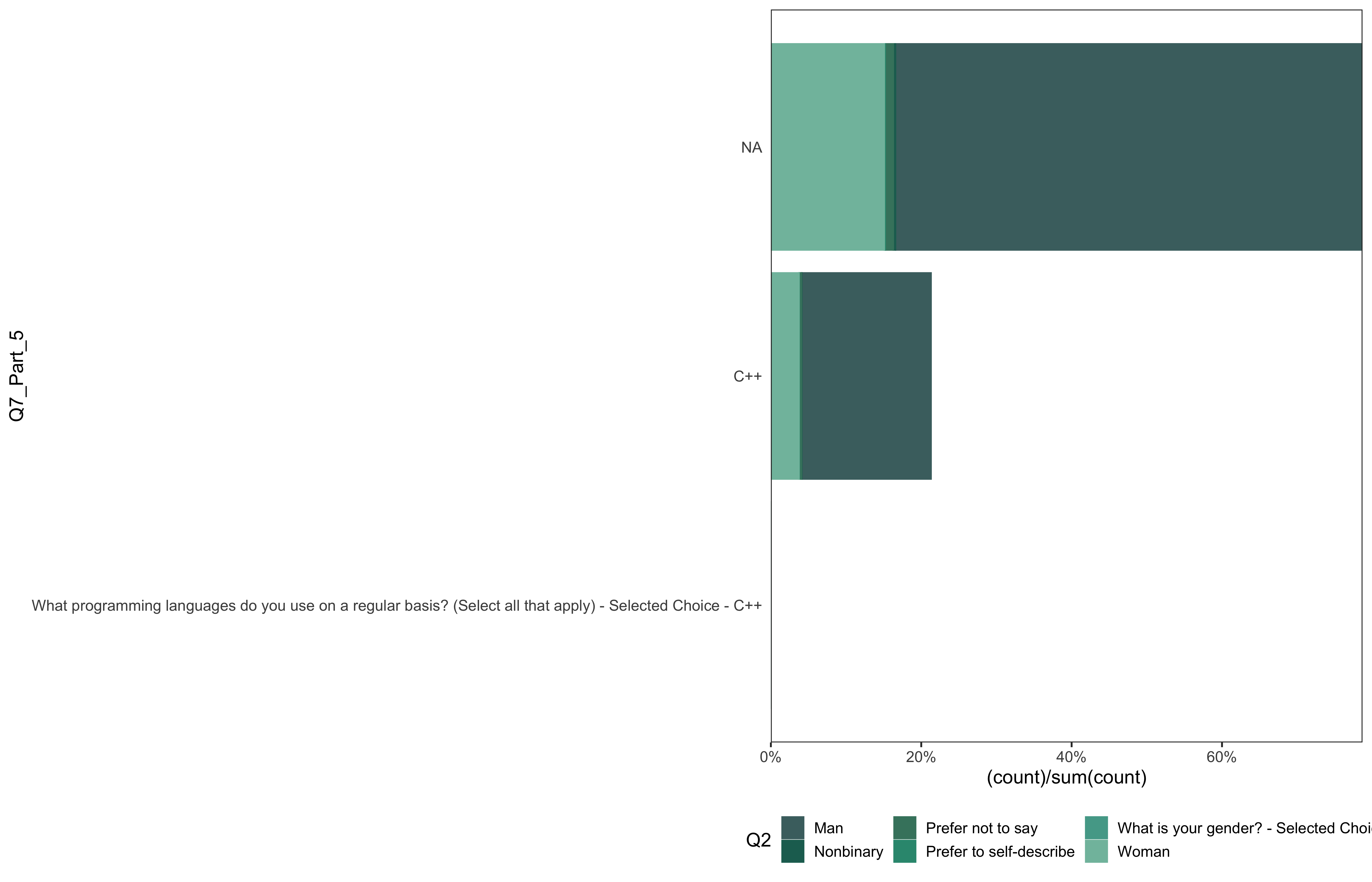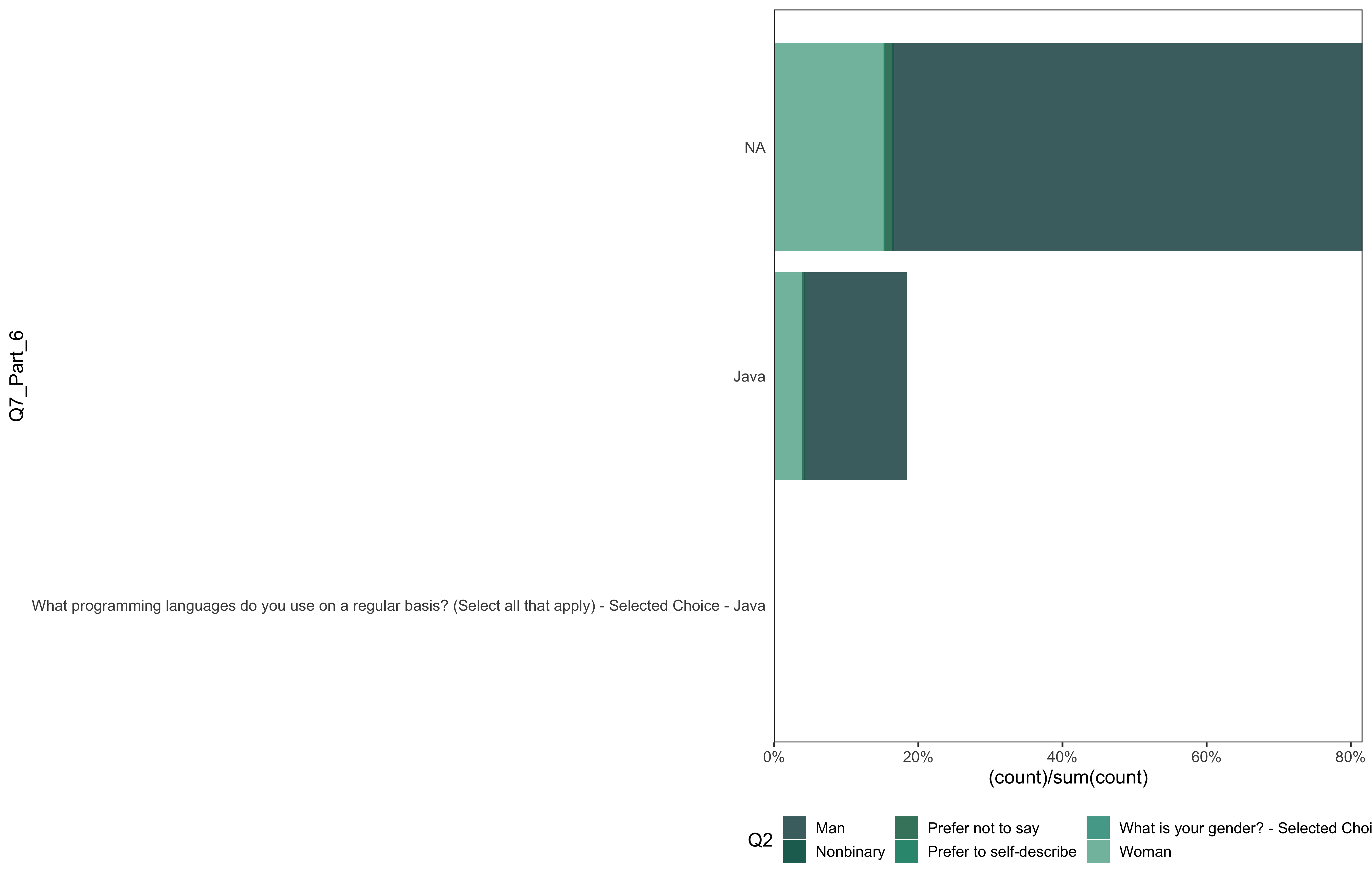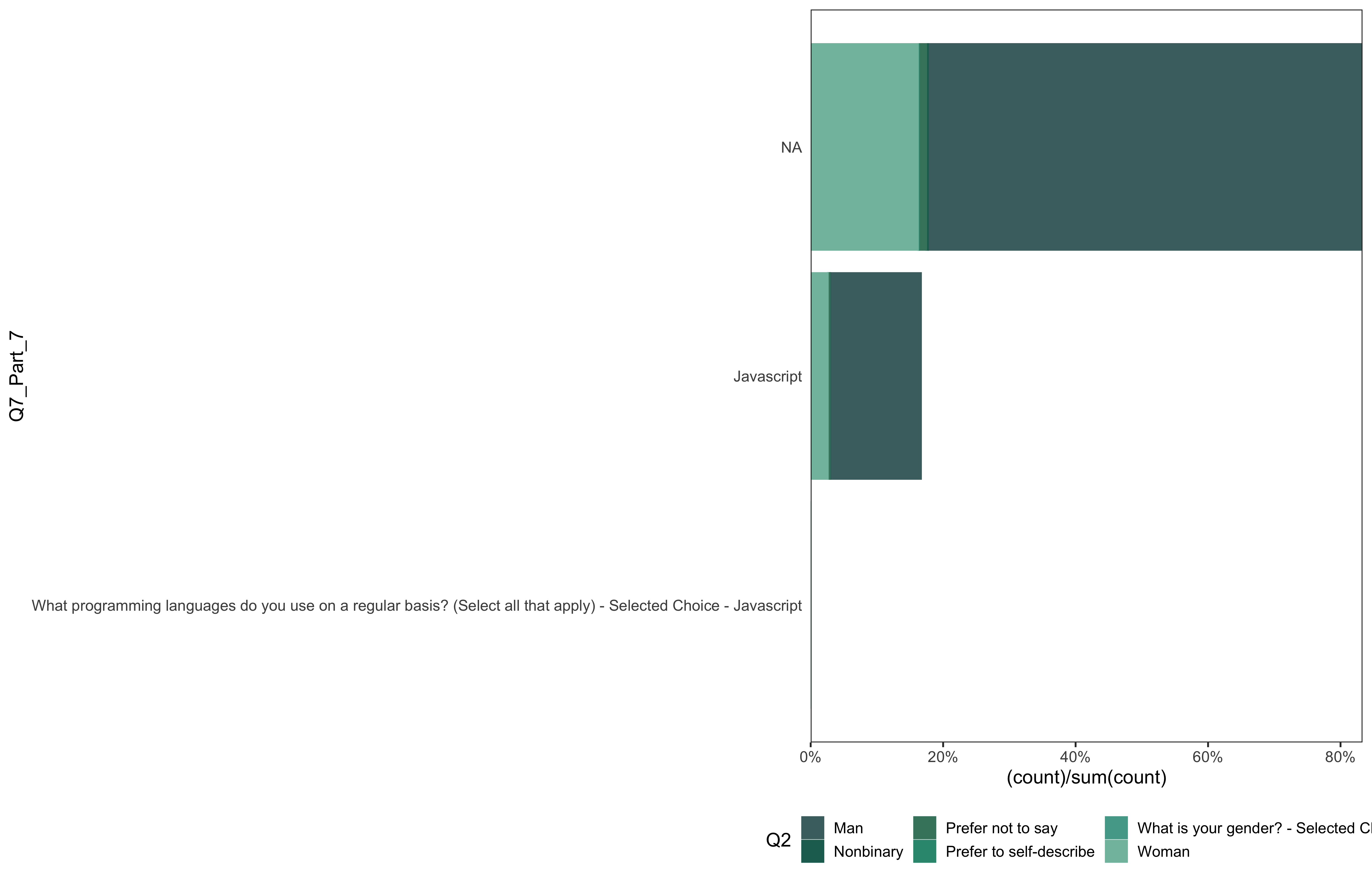Kaggle ML survey 2021
I am a doctoral student. I often wonder what my future holds in this brave and largely liberated according to some world. In EU, although 48% of doctoral graduates were women according to She Figures 2021, only 34% of researchers are women and only 24% of heads of higher education institutions are women. Even worse the situation is with equality in inventorship, where only 10% are women. This is women to men ratio of 0.12%.
I was wondering for a while now, what is the gender distribution among Kaggle participants in recent years. I took 2021 data as a study case and looked at the gender distribution among respondents of several survey questions.
Data
The data I use are available here.
library(tidyverse)
library(magrittr)
library(hermitage)
data <- read_csv(file = paste0(path, "kaggle_survey_2021_responses.csv"))
## Rows: 25974 Columns: 369
## ── Column specification ────────────────────────────────────────────────────────
## Delimiter: ","
## chr (369): Time from Start to Finish (seconds), Q1, Q2, Q3, Q4, Q5, Q6, Q7_P...
##
## ℹ Use `spec()` to retrieve the full column specification for this data.
## ℹ Specify the column types or set `show_col_types = FALSE` to quiet this message.
Exploratory plots
data %>%
ggplot(aes(x = Q1)) +
geom_bar(aes(y = (..count..)/sum(..count..))) +
theme_bw(base_size = 14) +
scale_y_continuous(expand = c(0, 0), labels = scales::percent) +
theme(plot.caption = element_text(hjust = 0, size = 10),
legend.position = "bottom",
panel.spacing = unit(0.8, "cm"),
panel.grid = element_blank(),
axis.ticks.y = element_blank()) +
coord_flip()

data %>%
ggplot(aes(x = Q2)) +
geom_bar(aes(y = (..count..)/sum(..count..))) +
theme_bw(base_size = 14) +
scale_y_continuous(expand = c(0, 0), labels = scales::percent) +
theme(plot.caption = element_text(hjust = 0, size = 10),
legend.position = "bottom",
panel.spacing = unit(0.8, "cm"),
panel.grid = element_blank(),
axis.ticks.y = element_blank()) +
coord_flip()

data %>%
ggplot(aes(x = Q1, group = Q2, color = Q2, fill = Q2)) +
geom_bar(aes(y = (..count..)/sum(..count..)), position = position_stack()) +
theme_bw(base_size = 14) +
scale_y_continuous(expand = c(0, 0), labels = scales::percent) +
theme(plot.caption = element_text(hjust = 0, size = 10),
legend.position = "bottom",
panel.spacing = unit(0.8, "cm"),
panel.grid = element_blank(),
axis.ticks.y = element_blank()) +
coord_flip() +
scale_color_manual(values = hermitage::hermitage_palette(name = "hermitage_1")) +
scale_fill_manual(values = hermitage::hermitage_palette(name = "hermitage_1"))

data %>%
mutate(
Q3 = fct_lump_min(Q3, min = 50),
Q3 = factor(Q3),
Q3 = fct_rev(fct_infreq(Q3))
) %>%
ggplot(aes(x = Q3)) +
geom_bar(aes(y = (..count..)/sum(..count..))) +
theme_bw(base_size = 14) +
scale_y_continuous(expand = c(0, 0), labels = scales::percent) +
theme(plot.caption = element_text(hjust = 0, size = 10),
legend.position = "bottom",
panel.spacing = unit(0.8, "cm"),
panel.grid = element_blank(),
axis.ticks.y = element_blank()) +
coord_flip()

go <- function(.data, variable, group = Q2){
.data %>%
mutate(
{{ variable }} := factor({{ variable }}),
{{ variable }} := fct_rev(fct_infreq({{ variable }}))
) %>%
ggplot(aes(x = {{ variable }}, group = {{ group }}, fill = {{ group }}, color = {{ group }})) +
geom_bar(aes(y = (..count..)/sum(..count..))) +
theme_bw(base_size = 14) +
scale_y_continuous(expand = c(0, 0), labels = scales::percent) +
theme(plot.caption = element_text(hjust = 0, size = 10),
legend.position = "bottom",
panel.spacing = unit(0.8, "cm"),
panel.grid = element_blank(),
axis.ticks.y = element_blank()) +
coord_flip() +
scale_color_manual(values = hermitage::hermitage_palette(name = "hermitage_1")) +
scale_fill_manual(values = hermitage::hermitage_palette(name = "hermitage_1"))
}
data %>%
go(Q3)

data %>%
go(Q4)

data %>%
go(Q5)

data %>%
go(Q6)

# mutually exclusive answers
data %>%
go(Q7_Part_1)

data %>%
go(Q7_Part_2)

data %>%
go(Q7_Part_3)

data %>%
go(Q7_Part_4)

data %>%
go(Q7_Part_5)

data %>%
go(Q7_Part_6)

data %>%
go(Q7_Part_7)

data_2 <-
data %>%
select(Q2, Q7_Part_1:Q7_OTHER) %>%
filter(row_number() != 1) %>%
unite(col = "Q7", Q7_Part_1:Q7_Part_7, sep = ", ", na.rm = T) %>%
filter(Q7 != "")
data_2 %>%
count(Q7)
## # A tibble: 124 × 2
## Q7 n
## <chr> <int>
## 1 C 129
## 2 C, C++ 111
## 3 C, C++, Java 49
## 4 C, C++, Java, Javascript 5
## 5 C, C++, Javascript 13
## 6 C, Java 30
## 7 C, Java, Javascript 7
## 8 C, Javascript 6
## 9 C++ 130
## 10 C++, Java 25
## # … with 114 more rows
data_2 %>%
mutate(
Q7 = fct_lump_min(Q7, min = 50)
) %>%
go(Q7)

data %>%
go(Q8)

data_3 <-
data %>%
select(Q2, Q9_Part_1:Q9_OTHER) %>%
filter(row_number() != 1) %>%
unite(col = "Q9", Q9_Part_1:Q9_OTHER, sep = ", ", na.rm = T) %>%
filter(Q9 != "")
data_3 %>%
count(Q9)
## # A tibble: 1,330 × 2
## Q9 n
## <chr> <int>
## 1 Jupyter (JupyterLab, Jupyter Notebooks, etc) 290
## 2 Jupyter (JupyterLab, Jupyter Notebooks, etc), Jupyter Notebook 366
## 3 Jupyter (JupyterLab, Jupyter Notebooks, etc), Jupyter Notebook, Other 33
## 4 Jupyter (JupyterLab, Jupyter Notebooks, etc), MATLAB 11
## 5 Jupyter (JupyterLab, Jupyter Notebooks, etc), MATLAB, Jupyter Notebook 28
## 6 Jupyter (JupyterLab, Jupyter Notebooks, etc), MATLAB, Jupyter Notebook… 3
## 7 Jupyter (JupyterLab, Jupyter Notebooks, etc), Notepad++ 21
## 8 Jupyter (JupyterLab, Jupyter Notebooks, etc), Notepad++, Jupyter Noteb… 61
## 9 Jupyter (JupyterLab, Jupyter Notebooks, etc), Notepad++, Jupyter Noteb… 1
## 10 Jupyter (JupyterLab, Jupyter Notebooks, etc), Notepad++, MATLAB 3
## # … with 1,320 more rows
data_3 %>%
mutate(
Q9 = fct_lump_min(Q9, min = 100)
) %>%
go(Q9)

data_4 <-
data %>%
select(Q2, Q10_Part_1:Q10_OTHER) %>%
filter(row_number() != 1) %>%
unite(col = "Q10", Q10_Part_1:Q10_OTHER, sep = ", ", na.rm = T) %>%
filter(Q10 != "")
data_4 %>%
count(Q10)
## # A tibble: 723 × 2
## Q10 n
## <chr> <int>
## 1 Amazon EMR Notebooks 40
## 2 Amazon EMR Notebooks, Databricks Collaborative Notebooks 1
## 3 Amazon EMR Notebooks, Databricks Collaborative Notebooks, Zeppelin / Z… 2
## 4 Amazon EMR Notebooks, Google Cloud Datalab 8
## 5 Amazon EMR Notebooks, Google Cloud Notebooks (AI Platform / Vertex AI) 8
## 6 Amazon EMR Notebooks, Google Cloud Notebooks (AI Platform / Vertex AI)… 5
## 7 Amazon EMR Notebooks, Google Cloud Notebooks (AI Platform / Vertex AI)… 1
## 8 Amazon EMR Notebooks, Google Cloud Notebooks (AI Platform / Vertex AI)… 2
## 9 Amazon EMR Notebooks, Other 2
## 10 Amazon EMR Notebooks, Zeppelin / Zepl Notebooks 3
## # … with 713 more rows
data_4 %>%
mutate(
Q10 = fct_lump_min(Q10, min = 100)
) %>%
go(Q10)

data %>%
go(Q11)

data_5 <-
data %>%
select(Q2, Q12_Part_1:Q12_OTHER) %>%
filter(row_number() != 1) %>%
unite(col = "Q12", Q12_Part_1:Q12_OTHER, sep = ", ", na.rm = T) %>%
filter(Q12 != "")
data_5 %>%
count(Q12)
## # A tibble: 26 × 2
## Q12 n
## <chr> <int>
## 1 AWS Inferentia Chips 137
## 2 AWS Inferentia Chips, Other 2
## 3 AWS Trainium Chips 133
## 4 AWS Trainium Chips, AWS Inferentia Chips 41
## 5 AWS Trainium Chips, Other 1
## 6 Google Cloud TPUs 2067
## 7 Google Cloud TPUs, AWS Inferentia Chips 52
## 8 Google Cloud TPUs, AWS Trainium Chips 51
## 9 Google Cloud TPUs, AWS Trainium Chips, AWS Inferentia Chips 35
## 10 Google Cloud TPUs, AWS Trainium Chips, Other 2
## # … with 16 more rows
data_5 %>%
mutate(
Q12 = fct_lump_min(Q12, min = 100)
) %>%
go(Q12)

data %>%
go(Q13)

data_6 <-
data %>%
select(Q2, Q14_Part_1:Q14_OTHER) %>%
filter(row_number() != 1) %>%
unite(col = "Q14", Q14_Part_1:Q14_OTHER, sep = ", ", na.rm = T) %>%
filter(Q14 != "")
data_6 %>%
count(Q14)
## # A tibble: 467 × 2
## Q14 n
## <chr> <int>
## 1 Altair 21
## 2 Altair, Bokeh, Leaflet / Folium 1
## 3 Altair, Geoplotlib 1
## 4 Altair, Leaflet / Folium 2
## 5 Altair, Other 1
## 6 Bokeh 30
## 7 Bokeh, Geoplotlib 3
## 8 Bokeh, Geoplotlib, Leaflet / Folium 1
## 9 Bokeh, Leaflet / Folium 2
## 10 Bokeh, Other 1
## # … with 457 more rows
data_6 %>%
mutate(
Q14 = fct_lump_min(Q14, min = 100)
) %>%
go(Q14)

data %>%
go(Q15)

data_7 <-
data %>%
select(Q2, Q16_Part_1:Q16_OTHER) %>%
filter(row_number() != 1) %>%
unite(col = "Q16", Q16_Part_1:Q16_OTHER, sep = ", ", na.rm = T) %>%
filter(Q16 != "")
data_7 %>%
count(Q16)
## # A tibble: 1,401 × 2
## Q16 n
## <chr> <int>
## 1 Caret 72
## 2 Caret, Other 2
## 3 Caret, PyTorch Lightning 1
## 4 Caret, Tidymodels 35
## 5 CatBoost 20
## 6 CatBoost, Caret 1
## 7 CatBoost, Huggingface 1
## 8 CatBoost, JAX 2
## 9 CatBoost, JAX, PyTorch Lightning 1
## 10 CatBoost, Prophet 1
## # … with 1,391 more rows
data_7 %>%
mutate(
Q16 = fct_lump_min(Q16, min = 100)
) %>%
go(Q16)

data_8 <-
data %>%
select(Q2, Q17_Part_1:Q17_OTHER) %>%
filter(row_number() != 1) %>%
unite(col = "Q17", Q17_Part_1:Q17_OTHER, sep = ", ", na.rm = T) %>%
filter(Q17 != "")
data_8 %>%
count(Q17)
## # A tibble: 756 × 2
## Q17 n
## <chr> <int>
## 1 Bayesian Approaches 87
## 2 Bayesian Approaches, Convolutional Neural Networks 14
## 3 Bayesian Approaches, Convolutional Neural Networks, Generative Adversa… 4
## 4 Bayesian Approaches, Convolutional Neural Networks, Generative Adversa… 1
## 5 Bayesian Approaches, Convolutional Neural Networks, Generative Adversa… 2
## 6 Bayesian Approaches, Convolutional Neural Networks, Recurrent Neural N… 11
## 7 Bayesian Approaches, Convolutional Neural Networks, Recurrent Neural N… 4
## 8 Bayesian Approaches, Convolutional Neural Networks, Transformer Networ… 3
## 9 Bayesian Approaches, Dense Neural Networks (MLPs, etc) 10
## 10 Bayesian Approaches, Dense Neural Networks (MLPs, etc), Convolutional … 7
## # … with 746 more rows
data_8 %>%
mutate(
Q17 = fct_lump_min(Q17, min = 300)
) %>%
go(Q17)

data %>%
go(Q20)

data %>% go(Q21)

data %>%
go(Q22)

data %>%
go(Q25)

Take home message
- Women and especially non-binary people are still underrepresented in STEM in 2021 and Kaggle survey did not show gender distribution any close to equal.